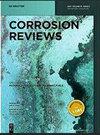现有天然气输送管道中的氢混合:氢脆,控制规范和寿命预测方法的回顾
IF 2.7
4区 材料科学
Q3 ELECTROCHEMISTRY
引用次数: 3
摘要
摘要现有的天然气管道为在设想的氢气经济中运输氢气(H2)提供了一种经济的替代方案。氢气会溶解在钢中,导致氢脆(HE),损害管道结构的完整性。HE引起亚临界裂纹,降低延性和断裂韧性,并增加疲劳裂纹扩展速率(FCGR)。这项工作分析了用于量化这些影响的气态氢测试标准。适用于氢气管道的设计规范ASME B31.12比通常用于建造天然气管道的ASME B31.8有更严格的要求。总结了这些规范规定的材料要求的差异。ASME B31.12管道规范适用于浓度大于10%摩尔的H2。然而,最近的测试程序承认,无论H2在混合物中的百分比如何,H2都会降低钢的机械性能。本文讨论了氢气降解的机械性能如何影响管道的完整性。机械性能的降低会导致有缺陷管道的故障压力下降,根据适用性方法进行计算。随着母材和焊缝硬度的增加,H2中亚临界裂纹扩展的风险越来越大。本文分析了现有管道中预计存在的高硬度和易受微观结构影响的区域。本文章由计算机程序翻译,如有差异,请以英文原文为准。
Hydrogen blending in existing natural gas transmission pipelines: a review of hydrogen embrittlement, governing codes, and life prediction methods
Abstract Existing natural gas pipelines provide an economic alternative for the transport of hydrogen (H2) in an envisioned hydrogen economy. Hydrogen can dissolve in the steel and cause hydrogen embrittlement (HE), compromising pipeline structural integrity. HE causes subcritical cracking, decreases ductility and fracture toughness, and increases the fatigue crack growth rate (FCGR). This work analyzes the testing standards in gaseous hydrogen used to quantify those effects. Design code ASME B31.12 applicable to hydrogen pipelines has more stringent requirements than ASME B31.8 code commonly used for constructing natural gas pipelines. Differences in materials requirements specified by those codes are summarized. ASME B31.12 pipeline code applies for H2 at a concentration greater than 10% molar. However, recent testing programs acknowledge that H2 degrades steel mechanical properties regardless of its percentage in the blend. This paper discusses how the hydrogen degraded mechanical properties affect pipeline integrity. Decreased mechanical properties cause a drop in the failure pressure of a flawed pipeline, calculated following a fitness for service methodology. There is an increasing risk of subcritical crack growth in H2 as the hardness of base metal and welds increases. This paper analyzes where zones with high hardness and susceptible microstructures are expected in existing pipelines.
求助全文
通过发布文献求助,成功后即可免费获取论文全文。
去求助
来源期刊

Corrosion Reviews
工程技术-材料科学:膜
CiteScore
5.20
自引率
3.10%
发文量
44
审稿时长
4.5 months
期刊介绍:
Corrosion Reviews is an international bimonthly journal devoted to critical reviews and, to a lesser extent, outstanding original articles that are key to advancing the understanding and application of corrosion science and engineering in the service of society. Papers may be of a theoretical, experimental or practical nature, provided that they make a significant contribution to knowledge in the field.
 求助内容:
求助内容: 应助结果提醒方式:
应助结果提醒方式:


